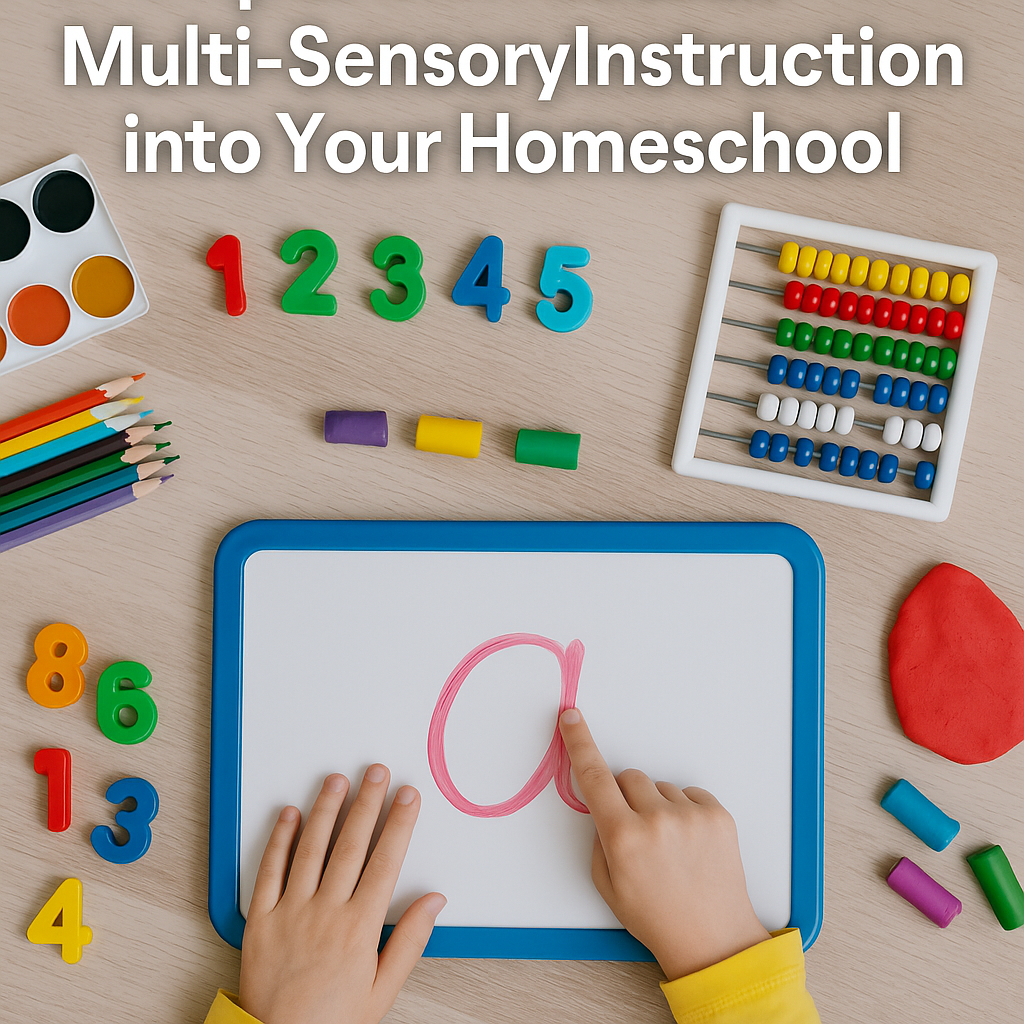(Even If You’re Just Getting Started)
Multi-sensory homeschool teaching is one way that today’s homeschool parents are discovering a simple, powerful way to help their children understand more, remember longer, and enjoy learning. It’s not just an educational trend. It’s a God-designed strategy that supports how children truly learn best.
Rather than relying on just one learning style, multi-sensory teaching combines sight, sound, touch, and movement to reach your child on multiple levels. Whether your learner is visual, auditory, kinesthetic, or somewhere in between, this method helps create “aha!” moments that stick.
✨ What Is Multi-sensory homeschool teaching?
Multi-sensory instruction is a teaching approach that engages more than one sense at a time. Instead of relying on lectures or worksheets alone, it encourages students to see, hear, touch, and even move as part of the learning process.
This style is especially beneficial for:
-
Early learners
-
Children with dyslexia, ADHD, or other learning differences
-
Kids who thrive through hands-on experiences
At HeroesMart Academy, we intentionally integrate multi-sensory strategies into our curriculum because we believe learning should be joyful, interactive, and God-honoring. There are many benefits to having a multi-sensory homeschool teaching environment for your young learner.
🧠 Benefits of Multi-Sensory Learning in Homeschooling
✅ Better Retention
Firstly, when multiple senses are used, the brain forms deeper connections. Instead of passively hearing information, your child interacts with it—and that means they’re more likely to remember it long-term.
✅ Stronger Engagement
So, you have wiggly learners? Easily distracted? Multi-sensory lessons keep kids actively involved, making learning feel more like play and less like a chore.
✅ Confidence Boost
Best of all, when a child finally “gets it” through a hands-on activity, it builds self-esteem. You’ll hear phrases like, “I did it all by myself!”—and that’s a beautiful moment for both student and parent.

🛠️ Easy Ways to Add Multi-Sensory Instruction to Your Day
✍️ 1. Trace Letters with Sound
For early readers, have your child trace letters with their finger or pencil while saying the letter sound out loud.
Example: Trace “S” while saying “ssss…snake.”
Senses used: Touch, vision, hearing
🔢 2. Use Math Manipulatives
Make math meaningful by letting kids touch, count, and group objects like:
-
Coins
-
Cereal pieces
-
LEGO bricks
-
Counting cubes
Ask them to talk out loud while working through the problem.
Senses used: Touch, sight, movement, speech
🍳 3. Cook and Learn in the Kitchen
Your kitchen is a classroom! Why not use it for multi-sensory homeschool teaching? Try:
-
Counting how many cookies come out of the oven
-
Comparing ingredient sizes and weights
-
Watching a baking soda + vinegar reaction
Senses used: All five—and delicious ones too!
🎒 Free & Affordable Tools You May Already Have
Remember, you don’t need a giant budget to get started with your multi-sensory homeschool teaching. Start with simple supplies:
| Tool | How It Helps |
|---|---|
| Chalk or whiteboard | Tracing, spelling, visualizing concepts |
| Playdough | Letter forming, fine motor development |
| Flashcards | Memory recall with sound and sight |
| Music & rhymes | Repetition for memory and rhythm |
| Picture books | Strengthens listening and visual processing |
| Bible coloring pages | Combines scripture with creativity |
🙌 How We Use Multi-Sensory Learning at HeroesMart Academy
At HeroesMart Homeschool Academy, our curriculum is built to engage children on every level:
-
📺 Video Lessons: For visual and auditory learners
-
📘 Printable Workbooks: Writing and drawing-based reinforcement
-
🗣️ Reflection Prompts: Encourage speech, movement, and prayer
-
🧠 Thinking Activities: Build logic and problem-solving through games and patterns
This approach helps students not only excel academically but grow in confidence and faith.
👪 Why it Works: A Faith-Based Perspective
Multi-sensory instruction works because it mirrors the way God designed children to learn—by exploring, touching, watching, speaking, and connecting. It encourages them to:
-
Learn joyfully
-
Retain information longer
-
Build strong spiritual foundations
And for you as a parent? It’s a beautiful way to meet your child right where they are—without stress, gimmicks, or confusion.
🙏 A Word of Encouragement for You
Dear homeschool parent:
You don’t have to be a trained teacher to give your child a great education. You simply need the heart to guide, explore, and be present. God will fill in the rest. 🌿
You are equipped—because He called you.
📣 Share This With Another Parent
Do you know a homeschool mom who needs a fresh start or a new spark to multi-sensory homeschool teaching?
Share this post—and let her know she’s not alone on this journey.
Let’s help more families discover the joy of Christ-centered, multi-sensory learning!
Register for the HeroesMart Pre-K Program
Get Our Ultimate Character Development Workbook
Free Curriculum Videos on YouTube
Sign Up for Weekly Encouragement & Freebies
Free, Expert-vetted Resources and Support
🧠 FAQs: Multi-Sensory Homeschooling
What age is best for multi-sensory instruction?
While it’s effective at all ages, this method is especially impactful for children in Pre-K through Grade 3.
Can this method help with ADHD or dyslexia?
Yes! Multi-sensory learning supports focus, memory, and comprehension for kids with learning challenges.
Is it time-consuming to implement?
Not at all. Most strategies can be blended into your normal day with simple tools and playful creativity.
🙌 – Mrs. Nita | HeroesMart Academy

Mrs. Nita is co-founder of HeroesMart Academy, co-creator of Godly Learners curriculum and lead instructor at https://www.youtube.com/@HeroesMartHomeschoolAcademy. When she’s not building homeschool content, you can find her enjoying time with her husband and four little ones.

